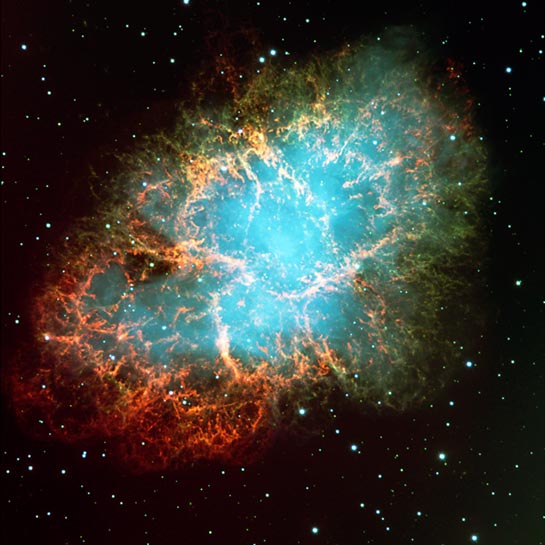
Description: Supernova Remnant
Position (J2000): RA 05hr 34m 31.96s Dec 22° 0' 51.38"
Constellation: Taurus
Visual magnitude: 8.4
Apparent dimensions: 420 × 290 arc-seconds
Distance: 6000 light years
Field of view: 6.82 x 6.86 arcminutes
Orientation: North is 0.1° right of vertical
Image Credit: ESO
Release date: November 17, 1999
Other images: S9948eo S0504sp S0537a S0537b S0909sp
ABOUT THIS IMAGE:
In this picture, the green light is predominantly produced by hydrogen emission from material ejected by the star that exploded. The blue light is predominantly emitted by very high-energy ("relativistic") electrons that spiral in a large-scale magnetic field (so-called synchrotron emission). It is believed that these electrons are continuously accelerated and ejected by the rapidly spinning neutron star at the center of the nebula and which is the remnant core of the exploded star. This pulsar has been identified with the lower/right of the two close stars near the geometric center of the nebula, immediately left of the small arc-like feature.
Technical information: This image is a composite of three images taken through three different optical filters: B (429 nm; FWHM 88 nm; 5 min; here rendered as blue), R (657 nm; FWHM 150 nm; 1 min; green) and S II (673 nm; FWHM 6 nm; 5 min; red) during periods of 0.65 arcsec (R, S II) and 0.80 (B) seeing, respectively. The field shown measures 6.8 x 6.8 arcminutes and the images were recorded in frames of 2048 x 2048 pixels, each measuring 0.2 arcseconds. North is up; East is left.
From Wikipedia:
The Crab Nebula (catalogue designations M1, NGC 1952, Taurus A) is a supernova remnant and pulsar wind nebula in the constellation of Taurus. Corresponding to a bright supernova recorded by Chinese astronomers in 1054, the nebula was observed later by English astronomer John Bevis in 1731. At an apparent magnitude of 8.4, comparable to that of the largest moon of Saturn, it is not visible to the naked eye but can be made out using binoculars under favourable conditions.
At X-ray and gamma ray energies above 30 keV, the Crab is generally the strongest persistent source in the sky, with measured flux extending to above 10 TeV. Located at a distance of about 6,500 light-years (2 kpc) from Earth, the nebula has a diameter of 11 light years (3.4 pc, corresponding to an apparent diameter of some 7 arc minutes) and expands at a rate of about 1,500 kilometers per second (0.5% c). It is part of the Perseus Arm of the Milky Way galaxy.
At the center of the nebula lies the Crab Pulsar, a neutron star 28–30 km across with a spin rate of 30.2 times per second, which emits pulses of radiation from gamma rays to radio waves. The nebula was the first astronomical object identified with a historical supernova explosion.
The nebula acts as a source of radiation for studying celestial bodies that occult it. In the 1950s and 1960s, the Sun's corona was mapped from observations of the Crab's radio waves passing through it, and in 2003, the thickness of the atmosphere of Saturn's moon Titan was measured as it blocked out X-rays from the nebula.
Modern understanding that the Crab Nebula was created by a supernova dates to 1921, when Carl Otto Lampland announced he had seen changes in the structure of the Crab Nebula. This eventually led to the nebula being linked to a bright supernova seen in 1054 A.D. by the 1940s
The creation of the Crab Nebula corresponds to the bright SN 1054 supernova recorded by Chinese astronomers in AD 1054
The Crab Nebula was first identified in 1731 by John Bevis. The nebula was independently rediscovered in 1758 by Charles Messier as he was observing a bright comet. Messier catalogued it as the first entry in his catalogue of comet-like objects.